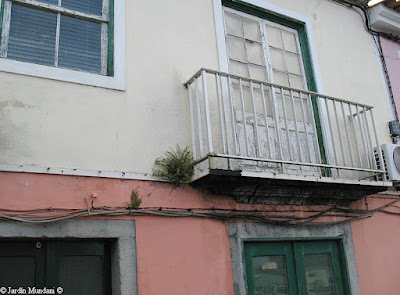The affinity for arsenic of fern Pteris vittata seems a contradiction. What explains the extreme toxicity of this metalloid find it beneficial? The answer is very simple: Pteris vittata accumulates arsenic in its fronds as a defense mechanism against predation by herbivores. Exactly the same as the caterpillars eat poisonous plants and accumulate in their tissues the poison to deter predators. Thus, if a herbivore eats the fronds of Pteris, suffering from severe intoxication and, if not die, will remember the rest of his life unpleasant experience and never going to eat again. This affinity for arsenic is shared by other ferns of order Pteridales such as Pteris cretica, Pityrogramma calomelanos, Pteris longifolia, Pteris umbrosa, etc ...
Magnificent specimens of Pteris vittata grown in the Botanical Garden of Soller in Majorca, with long fronds that can reach 130 cm.
This tendency to hyperaccumulate arsenic was discovered accidentally by finding the first specimens of Pteris vittata growing in Florida, specifically on land heavily contaminated by this metalloid. This detail was very appealing to botanists who made analyzing the composition of several fronds and found in them a high concentration of arsenic up to 1000 times higher than what is considered compatible with life, have been found up to 2.3% of Arsenic in tissues of the fronds.
Small feral Pteris vittata growing in a crack in the facade of a house in the city of Horta on Faial Island in the Azores Archipelago. On these islands, this fern allochthonous Atlantic has become a real plague, favored by high humidity throughout the year.
Facade of a house in the city of Horta on Faial Island with several specimens of Pteris vittata. The Azorean are forced to start each year, many ferns growing on the walls of their homes.
Ferns from above seen them closer. (Double click on the photo to enlarge)
Numerous studies have attempted to explain the tolerance of Pteridales to arsenic. The most accepted hypothesis is that once absorbed by the roots the fern fronds sends it where it undergoes a process of chelation (chemical neutralization) followed by a sequestration (encapsulation to isolate the cells).
Young feral Pteris vittata growing in a wall in full sun in the city of Tazacorte in the Canary island of La Palma.
Pteris vittata petioles much shorter than the lamina up to 15 cms. covered with trichomes.
Frond of fern above with their long leathery leaflets of entire margin.
Logically then saw the great possibilities offered by this fern to decontaminate soils with high concentrations of this poison. The results were startling, making back to life almost dead land, where nothing grew before.
Later some scientists thought in the possibility of using it to decontaminate water with high arsenic concentrations. This was done by hydroponic growing without soil, the roots of ferns directly submerged in contaminated water in containers. The results were even better than in the decontamination of soils. A single plant grown hydroponically in a container with 600 ml of contaminated water reduced the concentration of arsenic from 46 to less than 10 micrograms / liter in only three days, continuing decontamination in the following days, although at a slower speed.
Later some scientists thought in the possibility of using it to decontaminate water with high arsenic concentrations. This was done by hydroponic growing without soil, the roots of ferns directly submerged in contaminated water in containers. The results were even better than in the decontamination of soils. A single plant grown hydroponically in a container with 600 ml of contaminated water reduced the concentration of arsenic from 46 to less than 10 micrograms / liter in only three days, continuing decontamination in the following days, although at a slower speed.
Pteris vittata sori arranged in a submarginal line along the edge of pinnae with a subentire pseudoindusium. Sporangia in the sori of the photo are mature about to embark dispersal of spores.
Sporangium of Pteris vittata with the empty bag after dispersing the spores. The ring has numerous cells of vivid fire colour.. (Double click on the photo to enlarge)
And finally the microscopic picture of the beautiful spores with tetrahedral reticulated faces. (Double click on the photo to enlarge)
Reticulated faces of the spores.
Environmental arsenic pollution is a problem so serious that many methods have been devised both chemicals, which produce highly toxic waste, at times more polluting than arsenic itself as physical, such as nanofiltration, reverse osmosis, ion exchange , electrodialysis, whose high costs are prohibitive for the battered economies of many countries. Bio-Decontamination for the cultivation of Pteris vittata is therefore the best alternative, because of its simplicity, its excellent results in a short time and low cost.











thanks for interesting and clear article. Does anyone have any experience in trying it out? our soil has a reading of 30 to 300 ppm depending on the spot, and in New Zealand it is reccommended to be no higher than 17ppm. Love to hear from anyone with practical experience
ReplyDelete